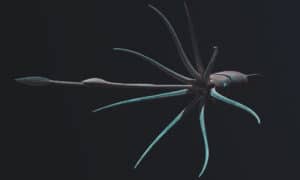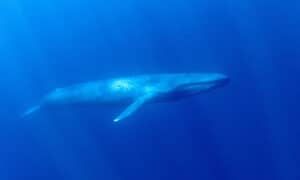Squids are venomous invertebrates with soft bodies and large eyes that belong to the mollusk family. Unlike octopuses with only eight arms, squids have eight arms and two tentacles, making them decapodiformes. Contrary to common misconception, these marine creatures aren’t always small and can measure anywhere from two to 43 feet long. Squids are exciting animals, especially where teeth are concerned. These animals have loads of teeth in various parts of their bodies that perform different functions.
What Parts of Squids’ Bodies Have Teeth?

Squids have teeth on their limbs and in their mouths.
©Gerald Robert Fischer/Shutterstock.com
There are more than 300 squid species characterized by teeth on their limbs and tentacles. The type and placement of squid teeth aren’t random or exactly similar across every species. Squids have another set of teeth in their mouths. We’ll address both teeth types.
Sucker Ring Teeth
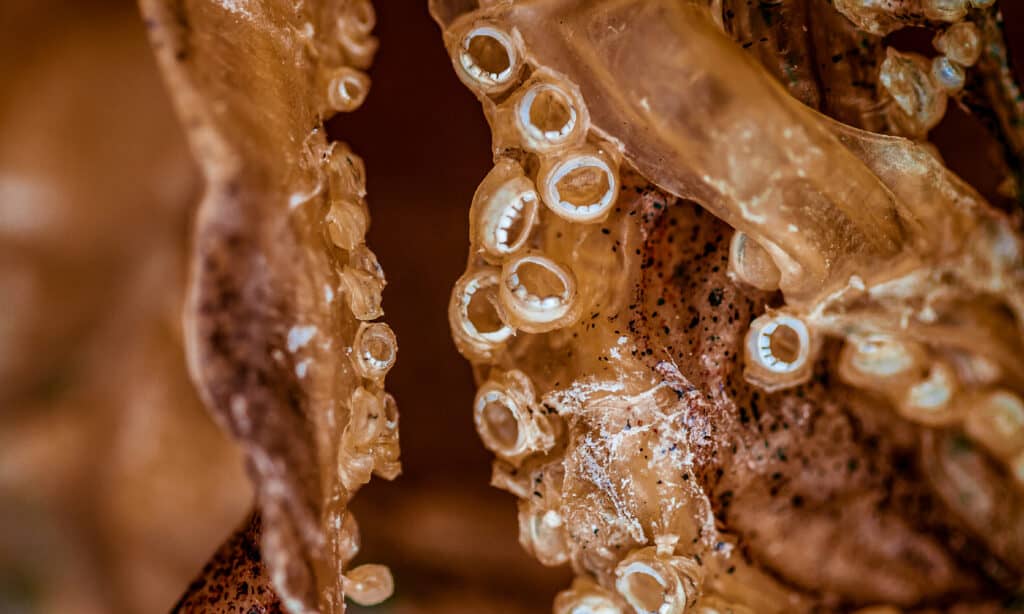
Squids have sucker ring teeth on their limbs.
©remotevfx.com/Shutterstock.com
Depending on their size, most squids’ arms and tentacles have hundreds and, sometimes, thousands of suction cups or suckers. Squids that do not have suckers have rotating hooks or a combination of hooks and suction cups.
Species with hooks use them to dig into prey, while those with suction cups can suck or pull prey toward them and stick on them. Each suction cup on a squid has a ring of tiny and extremely sharp teeth called sucker ring teeth.
A squid’s sucker ring teeth are another way its tentacles differ from an octopus’. Sucker ring teeth are made of suckerin proteins, which according to the National Museum of Natural History, are similar to the protein found in spiders’ silks. Interestingly, scientists are discovering ways to change sucker ring teeth into biodegradable plastics. Sucker ring teeth could also be used to coat fiber to help it self-heal from certain damages in the future.
What Do Squids Use Their Sucker Ring Teeth For?
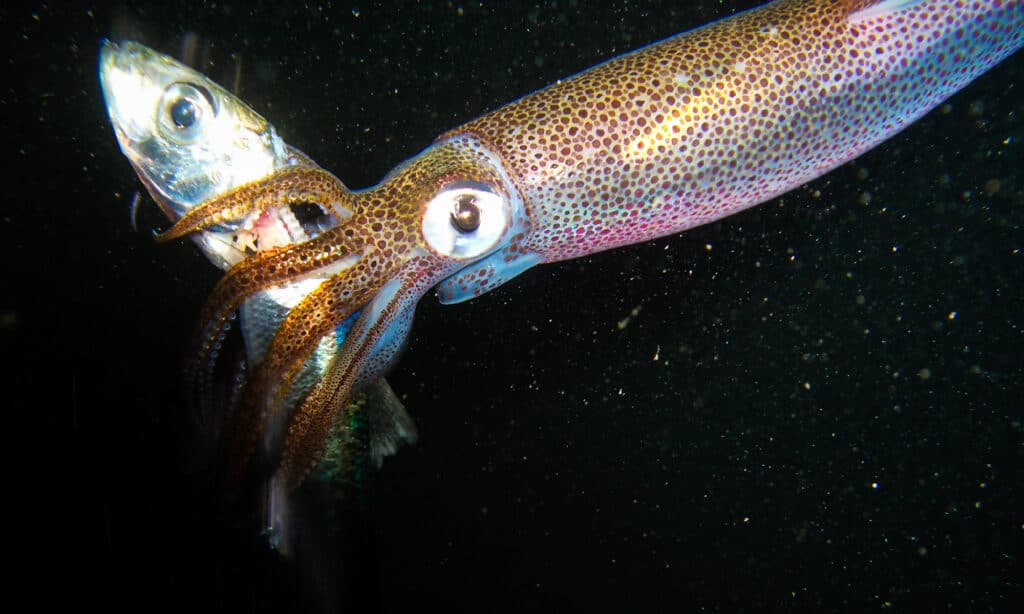
Squids use their sucker ring teeth to hold onto prey.
©iStock.com/Scubamoto
A 1974 study showed that squids use their sucker teeth for hunting, along with other parts of their bodies. When the squid’s flexible arms detect or touch prey, the animal quickly contrasts the muscles of its suction cups, allowing it to latch onto the prey. Then, the sharp sucker ring teeth bite into the prey and tighten the cups’ grip.
Do Squids Have Mouths?
Squids have mouths but also have beaks. Their beaks begin the first stage of digestion as their sucker ring teeth do nothing more than piercing and biting. Despite how soft squids are, their beaks are extremely hard and look quite similar to parrots’.
While most animals’ beaks contain some sort of metal or mineral, squids’ beaks are made only of organic chemicals but are still strong enough to kill and attack prey.
Squids use their beaks to kill prey and pluck their body parts apart. Larger squids even use their beaks to break their prey’s spine into two, effectively paralyzing them. When this is done, the beak passes the food into the mouth and to the radula.
Squids: Radulae and Teeth
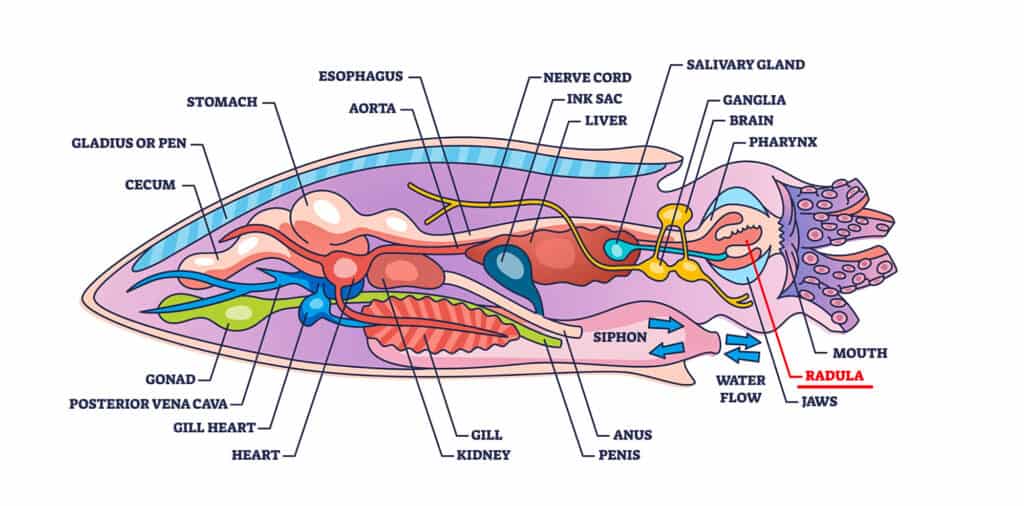
Squids have rows of teeth on their radulae.
©VectorMine/Shutterstock.com
Squids’ radulas or radulae are often compared to human tongues as they are also used for feeding. However, squids’ radulae have teeth on them. The radula has teeth arranged on it and is unique to each species, just as their sucker ring teeth are. The teeth on the radula are arranged in multiple rows and may be spiny or flat.
A squid’s tooth can be divided into the bottom section, the base, the middle section, the shaft, and the top cusp. The shaft and cusp are often continuous and cannot be strictly differentiated. These teeth are tightly fitted together, making removing them from the radula hard. Each row of a squid’s teeth on the radular has one middle or central tooth called the rachidian or rachis tooth.
What Do Squids Use Their Teeth For?
When food is passed to the radula, it is chewed into multiple small pieces by the teeth. When this food is chewed, it is passed down the squid’s throat. This process is important because squids’ throats, esophagus, and digestive systems pass through their brains, so they need their food bits to be extremely small.
Squids are cannibals and are known to display some of the highest levels of cannibalism among animals. When squids aren’t eating other squids, they can be found eating fish, cephalopods, and crustaceans.
Squids also have venomous glands which produce venom to help them defend and attack. It is believed that their venom is produced in the posterior salivary gland and transmitted through saliva. Squids are thought to inject their venom into their victims with the help of their beaks and radula.
In addition to their venom, squids also have ink which they produce as a defense mechanism to help them escape. Although their ink doesn’t contain venom, it could be toxic, especially if ingested.
What Is a Squid’s Bite Force?
Each squid species has a maximum bite force unique to its kind. The jumbo squid is said to have a bite force of more than one thousand pounds, much more than the lions‘. The giant squid and colossal squid, the larger squid species, produce suction forces rated above 800 kilopascals, about 100 pounds per square inch.
Do Squids Bite Humans?
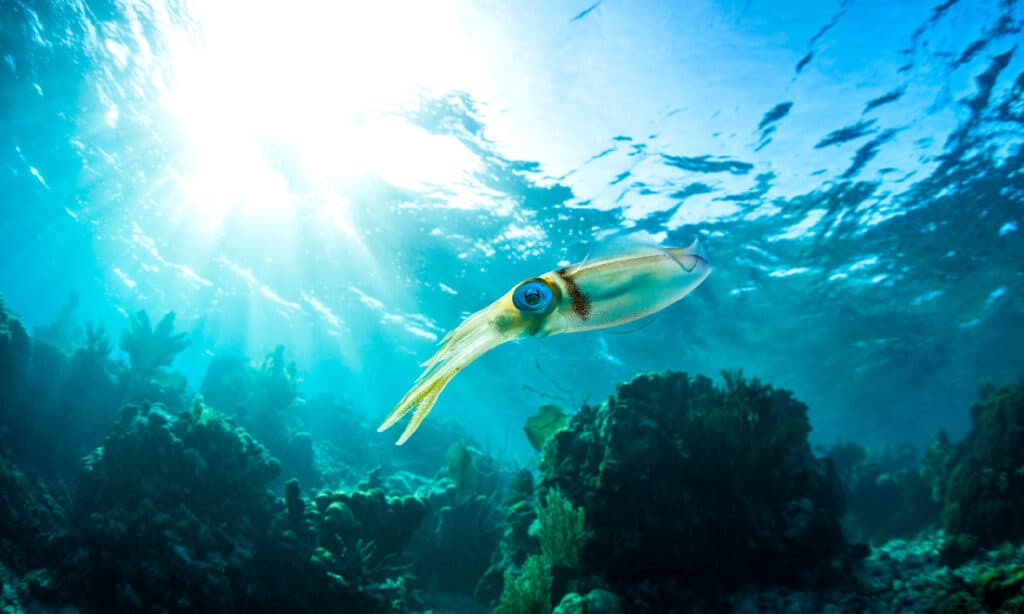
Squids can be aggressive and have been known to attack humans.
©iStock.com/MichaelStubblefield
Squids can be aggressive and have been known to attack humans, especially divers. However, attacks are more common from larger squids, who can use their tentacles to drag the divers below. They also use their sucker ring teeth to cut through the divers’ wetsuits and injure them.
Although there haven’t been any recorded and confirmed death by squids, there have been several attacks and serious injuries. Giant squids often pull divers down below the water with so much pressure that their eardrums could burst! Consequently, if you’re diving in a squid-infested area, ensure that you’re secure and protected.
Up Next:
Giant Squid vs. Colossal Squid
The photo featured at the top of this post is © mikeledray/Shutterstock.com
Sources
- Smithsonian, Available here: https://ocean.si.edu/ocean-life/invertebrates/giant-squid-beak-and-radula
- ACS Publications, Available here: https://pubs.acs.org/doi/10.1021/acsbiomaterials.6b00284
- Museum of New Zealand, Available here: https://www.tepapa.govt.nz/discover-collections/read-watch-play/science/anatomy-colossal-squid/arms-and-tentacles-colossal
Thank you for reading! Have some feedback for us? Contact the AZ Animals editorial team.




